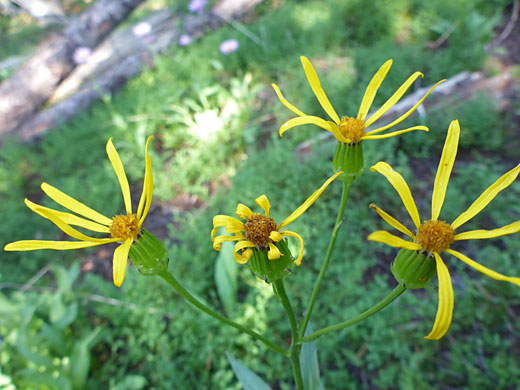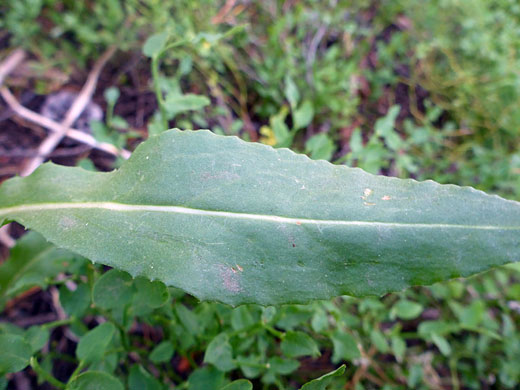
Green phyllaries and yellow rays of senecio crassulus - Titcomb Basin Trail, Wind River Range, Wyoming
Common name:
Thick leaf ragwort
Family:
Scientific name:
Senecio crassulus
Main flower color:
Range:
The Rocky Mountain states, and small parts of all states to the west, except Arizona and California
Height:
Up to 2 feet
Habitat:
Moist slopes and meadows, woodland margins; 7,300 to 12,000 feet
Leaves:
Elliptic to lanceolate, toothed, quite thick, up to 6 inches long and 2 inches wide
Season:
June to August
Senecio crassulus is fairly common in high elevation areas, in the Rocky Mountains and west into the Great Basin. Plants usually produce just one stem but sometimes up to four. Stems, leaves and phyllaries are hairless. Leaves are quite thick, and are lined by small teeth, shallow or sharp. Leaves have a wide, whitish center vein. Leaf bases taper to a short stalk, though upper stem leaves are sessile.
The inflorescence is an open cluster of between 4 and 12 flowerheads, held on thin green stalks several inches long. Flowerheads have a narrow center of several dozen ray florets surrounded by thin yellow ray florets, up to half an inch long, usually numbering 8 or 13. Beneath the florets are (respectively) 13 or 21 parallel, equal-length phyllaries, black at the tips. The involucre is subtended by 3 to 6 short, narrow bractlets (calyculi), which also have black tips.
The inflorescence is an open cluster of between 4 and 12 flowerheads, held on thin green stalks several inches long. Flowerheads have a narrow center of several dozen ray florets surrounded by thin yellow ray florets, up to half an inch long, usually numbering 8 or 13. Beneath the florets are (respectively) 13 or 21 parallel, equal-length phyllaries, black at the tips. The involucre is subtended by 3 to 6 short, narrow bractlets (calyculi), which also have black tips.
All Contents © Copyright The American Southwest | Comments and Questions | Contribute | Site Map


